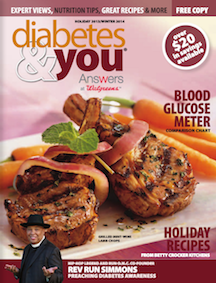- Amy Campbell, MS, RD, CDE
Now that (hopefully) you’re more aware of diabetes, you
might be wondering if it really can be prevented in the first place. Luckily, the answer is yes. We don’t know much yet about how to prevent
type 1 diabetes, the less common type, but we’ve learned that there are ways to
lower your risk of getting type 2 diabetes.
This is good news for the 79 million people who have prediabetes.
Here are a few action steps that you can take to lower your
risk. Some of them may be easier to do
than others. But they’re definitely
worth a try, especially if it means a longer, healthier life.
·
Lose
weight. I realize that you may have
heard this before, and I also understand that losing weight isn’t all that
easy. However, a landmark clinical
trial called the Diabetes Prevention Program (DPP) showed that type 2 diabetes
can be prevented or at least delayed in those at high risk. How is this possible? Researchers discovered that people in this
study who lost 5 to 7% of their body weight using lifestyle approaches (healthy
eating, physical activity, behavior change) lowered their risk of diabetes by
58%. That’s a big deal! And a 5 to 7% weight loss really isn’t all
that much. Let’s say you weigh 180 pounds. Losing 5 % of weight is 9 pounds,
and losing 7% is 13 pounds. We’re not
talking about losing 50 or 100 pounds.
Once these folks lost their weight, they benefited even more because
they were “protected” against diabetes for at least 10 more years. Understandably, the challenge for some
people is losing any amount of weight. Others may have no problem losing
weight, but keeping it off is the hard part.
Fortunately, how you lose the weight is up to you. In other words, there’s no one right diet out
there that will work for everyone. You
might decide to work with a dietitian, join a commercial program or try meal
replacements. Others may take a more
extreme approach and have bariatric surgery.
Choose an approach that you can stay with for the long haul. Fad diets and quick fixes aren’t the answer.
·
Get
moving. Now that the days are
shorter and the weather is colder, it’s all too easy to skip the after-dinner
walk or forgo a trip to the gym. Don’t
do it. Another finding from the DPP was
that people in the study exercised 150 minutes every week (or 30 minutes, 5
times a week). Exercise makes your
insulin work better and lowers blood glucose.
Your exercise program should include aerobics (walking, jogging,
dancing, biking) as well as strength, or resistance training. Resistance training can lower diabetes risk
by 34%. What counts as resistance
training? Using hand weights, resistance
bands, kettle bells, Nautilus at the gym or even your own body weight (think
pushups and lunges). Better yet, do both
aerobic and resistance training and slash your diabetes risk by 59%.
·
Give up
sugary drinks. Holiday punch, eggnog
or even just a cold glass of soda are treats, but don’t fill up on them. Besides that fact that they’re laden with
calories, studies show that drink even just one or two sugary beverages (soda,
juice, sports drinks, ice tea) can raise your risk of diabetes by as much as
25%. Water, seltzer water, unsweetened
tea and even diet soda are better choices.
·
Fill up
on fiber. Fiber isn’t all that
exciting but you might be excited to learn that it can help you lower your risk
of diabetes by up to 60%. Fiber is a
type of carbohydrate that isn’t well digested.
Foods high in fiber fill you up (so you eat less) and they also slow
down digestion which means that carbohydrate is more slowly broken down into
glucose. End result? Blood glucose levels tend to not spike up so
much when you’ve eaten a high fiber meal or food. Find fiber in whole wheat bread, brown rice,
fruits, vegetables and beans.
·
Get some
sleep. Many people in the U.S. don’t
get enough sleep. Besides making you
feel groggy and grumpy, a lack of sleep can lead to some very real health
concerns, such as heart disease, heart attack, stroke and yes, diabetes. Getting less than 6 hours of sleep per night
boosts your risk for diabetes. On the
other hand, getting more than 8 hours of sleep per night also raises your
risk. Aim for 7 to 8 hours each night –
not too much and not too little, either.
·
Go for
the grain. Carb foods aren’t
bad. Really. The key is to shy away from refined carbs,
like white bread, white rice and sugary treats.
Instead, choose whole grain bread and pasta, steel-cut oats and brown
rice. Studies show that getting two to
three servings of whole grains every day can lower diabetes risk by 30
percent. A serving is ½ cup of brown
rice, ½ cup cooked oatmeal or 1 slice of whole wheat bread.
Hopefully you can see that you’re in the driver’s seat when
it comes to diabetes. Of course, there’s
no guarantee that you won’t get diabetes, but there’s much that you can do to
try and prevent it. Even if you do
develop diabetes down the road, the lifestyle changes mentioned above can
provide many other health benefits, like keep your heart and blood vessels
healthy, controlling your weight and improving your quality of life. What do you have to lose?
- Amy






